Note
This page was generated from docs/tutorials/11_VarQTE.ipynb.
Variational Quantum Time Evolution¶
This notebook demonstrates how to use the Variational Quantum Time Evolution (VarQTE) algorithm for computing the time evolving state under a given Hamiltonian. Specifically, it introduces variational quantum imaginary and real time evolution based on McLachlan’s variational principle, and shows how this can be leveraged using the time_evolvers.variational sub-module.
Introduction¶
The time evolution of a quantum state \(|\Psi\rangle\) is governed by the Schrödinger equation (here with \(\hbar \equiv 1\))
or without the factor \(i\) for imaginary time dynamics.
In VarQTE, the time evolution of the state \(|\Psi(t)\rangle\) is replaced by the evolution of parameters \(\theta(t)\) in a variational ansatz \(|\psi[\theta(t)]\) (Yuan et al. Quantum 3, 191). Using the McLachlan variational principle, the algorithm updates the parameters by minimizing the distance between the right-hand side and left-hand side of the equation above, that is
with the norm \(\| |\psi\rangle \| = \sqrt{\langle\psi | \psi\rangle}\). This is equivalent to solving the following linear system of equations
where
,
and
.
Running VarQTE¶
In this tutorial, we will use two classes that extend VarQTE, VarQITE (Variational Quantum Imaginary Time Evolution) and VarQRTE (Variational Quantum Real Time Evolution) for time evolution. We can use a simple Ising model on a spin chain to illustrate this. Let us
consider the following Hamiltonian:
where \(J\) stands for the interaction energy, and \(h\) represents an external field which is orthogonal to the transverse direction. \(Z_i\) and \(X_i\) are the Pauli operators on the spins. Taking \(L=2\), \(J=0.2\), and \(h =1\), the Hamiltonian and the magnetization \(\sum_i Z_i\) can be constructed using SparsePauliOp as follows:
[1]:
from qiskit.quantum_info import SparsePauliOp
hamiltonian = SparsePauliOp(["ZZ", "IX", "XI"], coeffs=[-0.2, -1, -1])
magnetization = SparsePauliOp(["IZ", "ZI"], coeffs=[1, 1])
Imaginary Time Evolution¶
Imaginary time evolution can be used, for example, to find the ground state or calculate the finite temperature expectation value of the system. Here, we will use the VarQITE class from time_evolvers.variational to compute a ground state energy. Firstly, we need to choose an ansatz. We can use efficient_su2 to easily construct an ansatz, setting the number of repetitions using reps.
[2]:
from qiskit.circuit.library import efficient_su2
ansatz = efficient_su2(hamiltonian.num_qubits, reps=1)
ansatz.draw("mpl")
[2]:
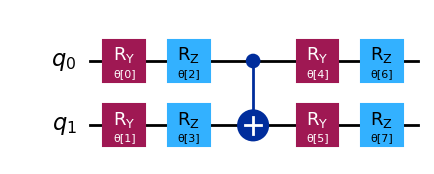
Here, we prepare a dictionary to store the initial parameters we set up, which determine the initial state.
[3]:
import numpy as np
init_param_values = {}
for i in range(len(ansatz.parameters)):
init_param_values[ansatz.parameters[i]] = np.pi / 2
Note that the initial state should be in overlap with the ground state.
Next, we choose ImaginaryMcLachlanPrinciple as the variational principle we’ll use later.
[4]:
from qiskit_algorithms.time_evolvers.variational import ImaginaryMcLachlanPrinciple
var_principle = ImaginaryMcLachlanPrinciple()
We set a target imaginary time \(t=5\), and set the Hamiltonian as an auxiliary operator. We create a TimeEvolutionProblem instance with hamiltonian, time, and aux_operators as arguments.
[5]:
from qiskit_algorithms import TimeEvolutionProblem
time = 5.0
aux_ops = [hamiltonian]
evolution_problem = TimeEvolutionProblem(hamiltonian, time, aux_operators=aux_ops)
We now use the VarQITE class to calculate the imaginary time evolving state. We can use VarQITE.evolve to get the results. Note this cell may take around \(1.5\) minutes to finish.
[6]:
from qiskit_algorithms import VarQITE
from qiskit.primitives import StatevectorEstimator
var_qite = VarQITE(ansatz, init_param_values, var_principle, StatevectorEstimator())
# an EstimatorV2 instance is necessary, if we want to calculate the expectation value of auxiliary operators.
evolution_result = var_qite.evolve(evolution_problem)
Exact Classical Solution¶
In order to check whether our calculation using VarQITE is correct or not, we also call SciPyImaginaryEvolver to help us calculate the exact solution.
Firstly, we can use qiskit.quantum_info.Statevector to help us get the statevector from the quantum circuit.
[7]:
from qiskit.quantum_info import Statevector
init_state = Statevector(ansatz.assign_parameters(init_param_values))
Then we can set up the evolving problem using SciPyImaginaryEvolver. Here we set number of time steps as \(501\).
[8]:
from qiskit_algorithms import SciPyImaginaryEvolver
evolution_problem = TimeEvolutionProblem(
hamiltonian, time, initial_state=init_state, aux_operators=aux_ops
)
exact_evol = SciPyImaginaryEvolver(num_timesteps=501)
sol = exact_evol.evolve(evolution_problem)
Results and Comparison¶
We use evolution_result.observables to get the variation over time of the expectation values of the Hamiltonian.
[9]:
import pylab
h_exp_val = np.array([ele[0][0] for ele in evolution_result.observables])
exact_h_exp_val = sol.observables[0][0].real
times = evolution_result.times
pylab.plot(times, h_exp_val, label="VarQITE")
pylab.plot(times, exact_h_exp_val, label="Exact", linestyle="--")
pylab.xlabel("Time")
pylab.ylabel(r"$\langle H \rangle$ (energy)")
pylab.legend(loc="upper right");
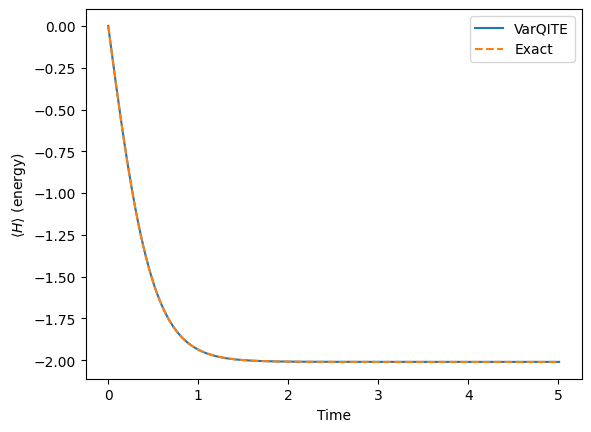
[10]:
print("Ground state energy", h_exp_val[-1])
Ground state energy -2.0097479079521197
As the above figure indicates, we have obtained the converged ground state energy.
Efficient classical calculation of gradients with VarQITE¶
You can use classically efficient gradient calculations to speed up the time evolution simulation by setting qgt to ReverseQGT() and gradient to ReverseEstimatorGradient().
[11]:
from qiskit_algorithms.gradients import ReverseEstimatorGradient, ReverseQGT
var_principle = ImaginaryMcLachlanPrinciple(qgt=ReverseQGT(), gradient=ReverseEstimatorGradient())
evolution_problem = TimeEvolutionProblem(hamiltonian, time, aux_operators=aux_ops)
var_qite = VarQITE(ansatz, init_param_values, var_principle, StatevectorEstimator())
evolution_result_eff = var_qite.evolve(evolution_problem)
In this example, it takes only \(1\) minute to calculate imaginary time evolution. The execution time is reduced by about 33% (this may vary for each execution, but generally results in a speedup).
[12]:
h_exp_val_eff = np.array([ele[0][0] for ele in evolution_result_eff.observables])
exact_h_exp_val_eff = sol.observables[0][0].real
times = evolution_result_eff.times
pylab.plot(times, h_exp_val_eff, label=r"VarQITE$_{eff}$")
pylab.plot(times, exact_h_exp_val_eff, label="Exact", linestyle="--")
pylab.xlabel("Time")
pylab.ylabel(r"$\langle H \rangle$ (energy)")
pylab.legend(loc="upper right");
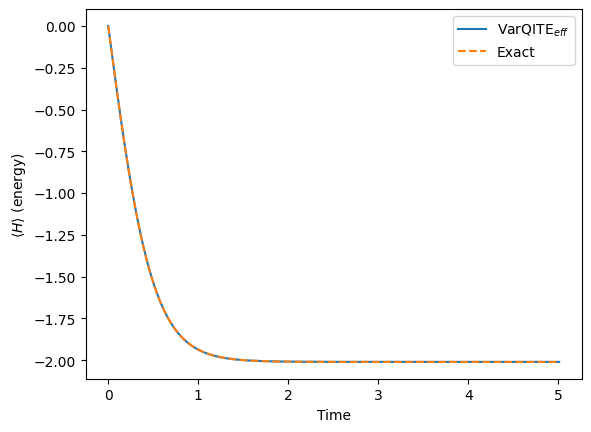
We can also get a converged result, which is consistent with the previous one.
[13]:
print("Ground state energy", h_exp_val_eff[-1])
Ground state energy -2.0097479079521183
Let us compare the performance of different methods. The error is defined as the difference between the results and exact solution for each method.
[14]:
pylab.plot(times, (h_exp_val - exact_h_exp_val), label="VarQITE")
pylab.plot(times, (h_exp_val_eff - exact_h_exp_val_eff), label=r"VarQITE$_{eff}$", linestyle="--")
pylab.xlabel("Time")
pylab.ylabel(r"$\Delta \langle H \rangle$")
pylab.legend(loc="upper right");
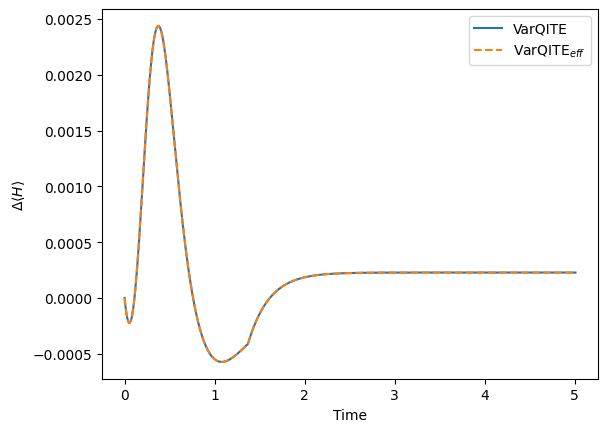
In this task, the accuracies of VarQITE with both gradient methods are very close, but ReverseEstimatorGradient() takes a considerably shorter time to run.
We can do the same comparison for VarQRTE for simulating the magnetization of the Ising model.
Real Time Evolution¶
Real time evolution is more suitable for tasks such as simulating quantum dynamics. For example, one can use VarQRTE to get time evolving expectation values of the magnetization.
VarQRTE¶
Again, the first step is to select an ansatz.
[15]:
ansatz = efficient_su2(hamiltonian.num_qubits, reps=1)
ansatz.draw("mpl")
[15]:
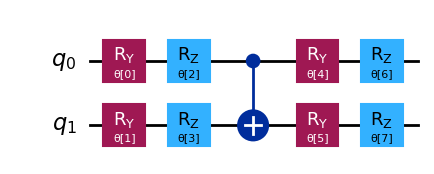
We set all initial parameters as \(\frac{\pi}{2}\).
[16]:
init_param_values = {}
for i in range(len(ansatz.parameters)):
init_param_values[ansatz.parameters[i]] = (
np.pi / 2
) # initialize the parameters which also decide the initial state
We also define an initial state:
[17]:
init_state = Statevector(ansatz.assign_parameters(init_param_values))
print(init_state)
Statevector([-5.00000000e-01+0.00000000e+00j,
-5.00000000e-01-5.55111512e-17j,
0.00000000e+00-5.00000000e-01j,
1.66533454e-16+5.00000000e-01j],
dims=(2, 2))
In order to use the real time McLachlan principle, we instantiate the RealMcLachlanPrinciple class.
[18]:
from qiskit_algorithms.time_evolvers.variational import RealMcLachlanPrinciple
var_principle = RealMcLachlanPrinciple()
We also set the target time as \(t=10\), and set the auxiliary operator to be the magnetization operator. The following steps are similar to VarQITE.
[19]:
aux_ops = [magnetization]
[20]:
from qiskit_algorithms import VarQRTE
time = 10.0
evolution_problem = TimeEvolutionProblem(hamiltonian, time, aux_operators=aux_ops)
var_qrte = VarQRTE(ansatz, init_param_values, var_principle, StatevectorEstimator())
evolution_result_re = var_qrte.evolve(evolution_problem)
We can also obtain the exact solution with SciPyRealEvolver. We first create the corresponding initial state for the exact classical method.
[21]:
init_circ = ansatz.assign_parameters(init_param_values)
SciPyRealEvolver can help us get the classical exact result.
[22]:
from qiskit_algorithms import SciPyRealEvolver
evolution_problem = TimeEvolutionProblem(
hamiltonian, time, initial_state=init_circ, aux_operators=aux_ops
)
rtev = SciPyRealEvolver(1001)
sol = rtev.evolve(evolution_problem)
We can compare the results, where \(m_z\) represents the magnetization.
[23]:
mz_exp_val_re = np.array([ele[0][0] for ele in evolution_result_re.observables])
exact_mz_exp_val_re = sol.observables[0][0].real
times = evolution_result_re.times
pylab.plot(times, mz_exp_val_re, label="VarQRTE")
pylab.plot(times, exact_mz_exp_val_re, label="Exact", linestyle="--")
pylab.xlabel("Time")
pylab.ylabel(r"$\langle m_z \rangle$")
pylab.legend(loc="upper right");
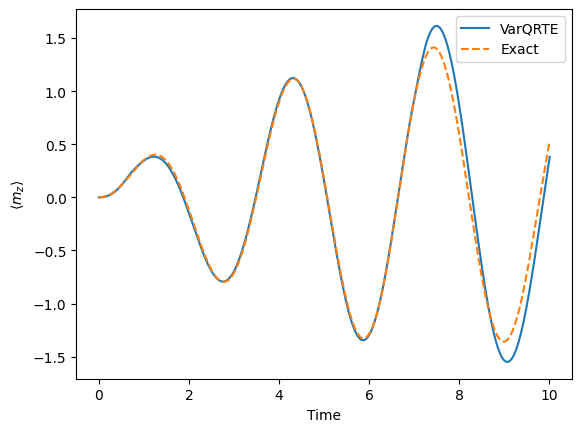
Efficient Way to run VarQRTE¶
Similarly, we can set qpt as ReverseQGT() and gradient as ReverseEstimatorGradient() to speed up the calculation.
[24]:
from qiskit_algorithms.gradients import DerivativeType
var_principle = RealMcLachlanPrinciple(
qgt=ReverseQGT(), gradient=ReverseEstimatorGradient(derivative_type=DerivativeType.IMAG)
)
time = 10.0
evolution_problem = TimeEvolutionProblem(hamiltonian, time, aux_operators=aux_ops)
var_qrte = VarQRTE(ansatz, init_param_values, var_principle, StatevectorEstimator())
evolution_result_re_eff = var_qrte.evolve(evolution_problem)
[25]:
mz_exp_val_re_eff = np.array([ele[0][0] for ele in evolution_result_re_eff.observables])
pylab.plot(times, mz_exp_val_re_eff, label=r"VarQRTE$_{eff}$")
pylab.plot(times, exact_mz_exp_val_re, label="Exact", linestyle="--")
pylab.xlabel("Time")
pylab.ylabel(r"$\langle m_z \rangle$")
pylab.legend(loc="upper right");

Again, the accuracies of VarQRTE with both gradient methods are very similar, while the ReverseEstimatorGradient() shows a speedup of about \(21\%\) in this execution.
[26]:
pylab.plot(times, (mz_exp_val_re - exact_mz_exp_val_re), label="VarQRTE")
pylab.plot(
times, (mz_exp_val_re_eff - exact_mz_exp_val_re), label=r"VarQRTE$_{eff}$", linestyle="--"
)
pylab.xlabel("Time")
pylab.ylabel(r"$\Delta \langle m_z \rangle$")
pylab.legend(loc="upper right");
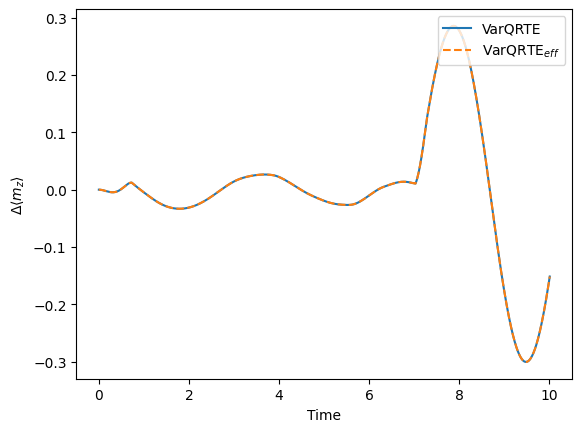
[27]:
import tutorial_magics
%qiskit_version_table
%qiskit_copyright
Version Information
| Software | Version |
|---|---|
qiskit | 2.0.3 |
qiskit_algorithms | 0.4.0 |
| System information | |
| Python version | 3.10.18 |
| OS | Linux |
| Tue Sep 09 09:59:56 2025 UTC | |
This code is a part of a Qiskit project
© Copyright IBM 2017, 2025.
This code is licensed under the Apache License, Version 2.0. You may
obtain a copy of this license in the LICENSE.txt file in the root directory
of this source tree or at http://www.apache.org/licenses/LICENSE-2.0.
Any modifications or derivative works of this code must retain this
copyright notice, and modified files need to carry a notice indicating
that they have been altered from the originals.